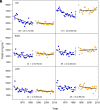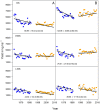Steady agronomic and genetic interventions are essential for sustaining productivity in intensive rice cropping
- PMID: 34740974
- PMCID: PMC8609317
- DOI: 10.1073/pnas.2110807118
Steady agronomic and genetic interventions are essential for sustaining productivity in intensive rice cropping
Abstract
Intensive systems with two or three rice (Oryza sativa L.) crops per year account for about 50% of the harvested area for irrigated rice in Asia. Any reduction in productivity or sustainability of these systems has serious implications for global food security. Rice yield trends in the world's longest-running long-term continuous cropping experiment (LTCCE) were evaluated to investigate consequences of intensive cropping and to draw lessons for sustaining production in Asia. Annual production was sustained at a steady level over the 50-y period in the LTCCE through continuous adjustment of management practices and regular cultivar replacement. Within each of the three annual cropping seasons (dry, early wet, and late wet), yield decline was observed during the first phase, from 1968 to 1990. Agronomic improvements in 1991 to 1995 helped to reverse this yield decline, but yield increases did not continue thereafter from 1996 to 2017. Regular genetic and agronomic improvements were sufficient to maintain yields at steady levels in dry and early wet seasons despite a reduction in the yield potential due to changing climate. Yield declines resumed in the late wet season. Slower growth in genetic gain after the first 20 y was associated with slower breeding cycle advancement as indicated by pedigree depth. Our findings demonstrate that through adjustment of management practices and regular cultivar replacement, it is possible to sustain a high level of annual production in irrigated systems under a changing climate. However, the system was unable to achieve further increases in yield required to keep pace with the growing global rice demand.
Keywords: food security; intensive cropping; long-term productivity trends; rice; sustainability.
Copyright © 2021 the Author(s). Published by PNAS.
Conflict of interest statement
The authors declare no competing interest.
Figures





References
-
- Zeigler R., Sustaining Global Food Security: The Nexus of Science and Policy (CSIRO Publishing, 2019).
-
- GRiSP (Global Rice Science Partnership), Rice Almanac (International Rice Research Institute, Los Baños, Philippines, 2013).
-
- Chandler R. F., An Adventure in Applied Science: A History of the International Rice Research Institute (International Rice Research Institute, 1992).
-
- Khush G. S., Breaking the yield frontier of rice. GeoJournal 35, 329–332 (1995).

